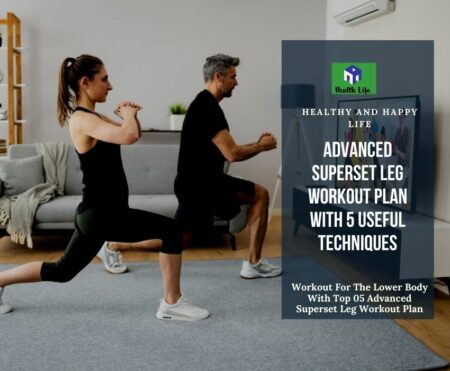Using complex movements to target the quadriceps, hamstrings, and gluteals in supersets is the key to this advanced lower body workout. A plyometric exercise is almost always included in the supersets. Even while it may seem counterintuitive to focus on building muscle and improving strength, you’ll also burn calories and train your body for more explosive and responsive movement. From this advanced superset leg workout plan, such as jumping and sprinting, or fast directional shifts required in sports like soccer or football.
As a bonus, this workout incorporates a variety of movement patterns. There are three planes of motion that you’ll be required to travel through: the frontal, sagittal and transverse. The way our bodies move in daily life and in various sports is more precisely modeled when we train in several planes of motion.
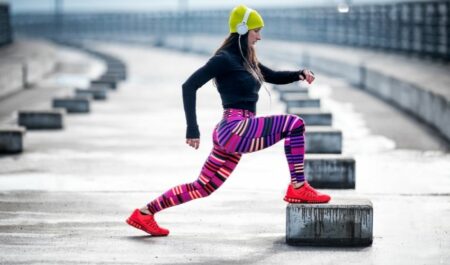
This exercise focuses mostly on the lower body, but your entire body will be tested. Expect to engage your core, chest, back, and arms to stabilize the body in many of these routines.
Precautions Of The Superset.
This is a difficult exercise. You should be in decent physical condition and have some prior experience working out on various types of fitness equipment. The first few times you use a piece of equipment, you should use as little weight as possible until you get the hang of it. It’s also possible to ask a buddy or a trainer to assist you out.
Equipment Can Use.
At the gym or in a well-equipped home gym, this workout may be completed. Barbell, weight plates, dumbbells or smith machines, a box or platform, a medicine ball and cones are some of the equipment you will need. Most gyms and fitness clubs include a weight room where you may locate most of these tools. If you don’t have a certain piece of equipment, there are several adjustments that may be made.
How To Do These Advanced Superset Workouts.
Light to moderate-intensity cardiovascular activity should be performed for 5–7 minutes before to exercise. Running, rowing, riding on a stationary bike, and even jumping rope are all examples of this type of exercise.
Begin with superset #1 and work your way through it once you’ve warmed up enough. It’s important to keep in mind that the goal of superset training is to go quickly from one exercise to the next. In between supersets, though, you can take a 30- to 60-second pause.
If you have the time, you may repeat each superset before going on to the next one if you like. You should be able to finish the exercise in around 40 minutes if you complete each superset once.
Choose two to four of the five supersets if doing all five is too much for you. Do a 3–5 minute cool down (on the track or treadmill) and some full-body stretches to cap up your workout.
The Superset Type #1.
The purpose of this superset is to get your body ready for the more strenuous workouts that will follow. This is the only one in which a plyometric exercise is omitted. The box step-up, on the other hand, will raise your heart rate significantly.
Squats With Weights.

Weighted squats target the quadriceps and glutes more than any other lower-body exercise. Dumbbells, kettlebells, or a smith machine can all be used for this workout.
- The feet should be hip-distance apart while a dumbbell is placed on each shoulder.
- To sit down on a low chair, keep your chest tall and your core engaged while you bend your knees and send your hips downward.
- The thighs should be at least parallel to the floor at this point.
- Stand tall, clenching your glutes at the top, and press into your heels. Repeat 7 to 10 times.
Good Morning Crossfit Workouts With Barbell.
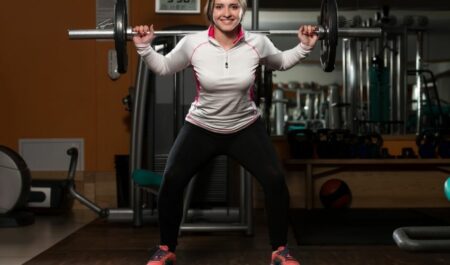
The hamstrings and core are the primary targets for this workout. The best way to start the day is to stand tall with your feet hip-distance apart. Using both hands, position a barbell on your upper back (the trapezius muscle). The weight plates should be collar-secured if you have added them to the bar.
- A modest flexion of the knees is all that is needed to bring the hips back while maintaining a forward lean of the torso (as if trying to shut a car door with your butt). Keep your back straight and your core strong.
- Return to the beginning position when you’ve reached a torso parallel to the floor.
- Continue with 10–12 repetitions.
Take Your Training To The Next Level By Adding Weights.
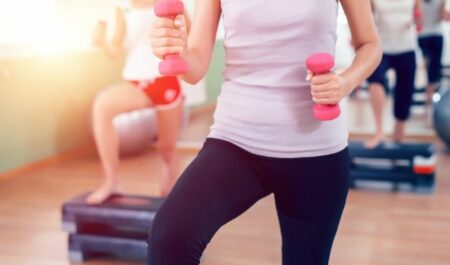
For this workout, you’ll need a strong step or box. A higher box is more difficult, but a shorter box is more straightforward. Starting in front of the box, with one weight in each hand, stand with your arms outstretched at shoulder-height.
- Make sure your full foot is on the box by stepping onto it with your right foot.
- Bring the left foot to meet the right foot by pressing through the right foot.
- Begin with your right foot and then your left.
- Ten repetitions leading with the right leg and ten repetitions leading with the left leg must be completed.
The Superset Type #2.
This superset will help you gain strength while also testing your coordination and balance. You may use dumbbells or kettlebells to increase the difficulty of these exercises, or you can do them with only your bodyweight.
Split Squat In Bulgarian Style.
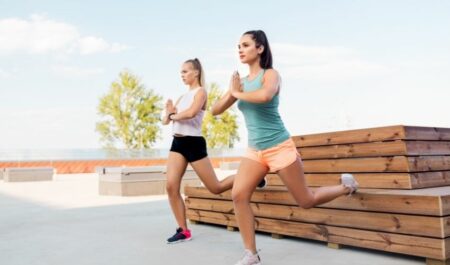
To get ready for the Bulgarian split squat, stand about two feet in front of a chair or bench with your feet hip-distance apart. Make sure your left foot is on the seat behind you with the top of your foot looking down. In front of your chest, hold a dumbbell or kettlebell in each hand.
- Lower yourself into a one-legged lunge by bending your right knee. As the torso drops to knee level, the shoulders remain erect above the hips.
- Lift the body back up to the starting posture while pressing through the right heel.
- Repeat the exercise seven to ten times with each leg.
Sumo Squat.

The sumo squat is a great way to activate the adductor muscles (the muscles on the inside thigh). Holding a kettlebell or dumbbell will help you gain weight.
- Slightly broader than hip-distance between your feet is ideal. Slightly widen your feet.
- Bring your hips and knees all the way to the floor (as if trying to sit in a low chair).
- Return to a standing position by pressing through the heels. Keep your core engaged and your weight properly distributed on both feet throughout the whole exercise. –
- Attempt seven to ten repetitions.
Jump Lunge
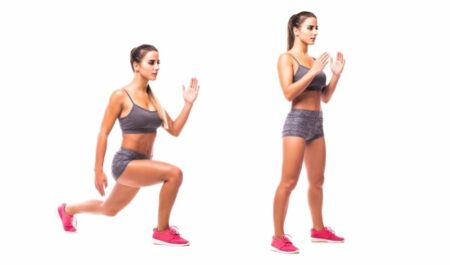
To increase your lower-explosive body’s strength and coordination, try doing some jump lunges. To keep your balance, you’ll also need to contract your abdominal muscles.
Set up in a lunge stance with the right leg out in front and the left behind before beginning this exercise. The knees of both are bent.
- Deepen your lunge and lean forward a bit as you prepare to leap off the ground. There are bent elbows on either side, with the left arm in front and the right arm in rear.
- Lift your body up quickly and explosively, allowing your knees and hips to completely stretch.
- The left leg should come forward first, followed by the right, and then swap when you come to a stop. The right arm should go forward and the left arm should go backwards.
- To prepare for your next jump, land lightly in a lunge stance and sink deeper into that lunge.
- Maintain stability and momentum with the core and arms as you continue to lunge, leap, switch, and land. Perform a total of 12–20 reps.
The Superset Type #3.
In this superset, you’ll incorporate rotation and lateral movement. If necessary, substitute other pieces of equipment.
Deadlift.
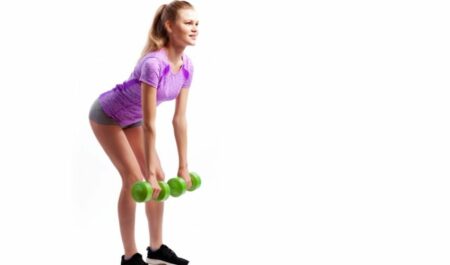
Strengthening the hamstrings and glutes with the deadlift is a proven method.34 Back and core stabilizers will also be used during the exercise. If you don’t have access to a barbell, you may execute this exercise using dumbbells.
The barbell should be placed on the floor in front of you, with weight plates if desired. Your toes should be positioned beneath the bar, and your feet should be shoulder-width apart.
- Hold the barbell outside your shins with your torso erect and your back flat as you lower your torso toward the back wall.
- In order to raise the bar, you must press your feet firmly into the ground (as if you were attempting to push the earth away from you). As you rise to a standing posture, the bar should almost touch your shins and rest on your thigh. Back and shoulders are powerful in an upright position, hips and knees and ankles are aligned.
- Make sure your back is flat and your chest is erect as you return the barbell to the beginning position by sending your hips backward and moving your hips backward. Repeat the raise and lower routine 7–10 times.
Lunge Twist.

This workout targets the core (particularly the obliques), shoulders, and legs while including a simple lunge. Your body is more prepared for tasks like shifting big things if you practice twisting motions. In the absence of a medicine ball, a dumbbell will suffice.
Step your right foot forward into a basic lunge stance before beginning this exercise. There is no weight on the rear heel. Stand with your arms outstretched and hold a medicine ball at chest height. Using a dumbbell when a med ball is unavailable is a good alternative. No weight is required in order to do this workout.
- Rotate your body to the right while keeping the ball in front of your chest. Maintain a firm core and glutes. Your attention is drawn to the ball (or slightly above).
- Bring your torso and attention back to where they were before. Check to see that your shoulders and hips are still in alignment. Switch sides and repeat 7–10 times on the right before moving to the left.
Lateral Jump.
Your training will benefit from including plyometric lateral jumps into your routine. You may utilize this to enhance your daily functions, as well as your performance in sports like tennis and soccer that need a lot of side-to-side movement.
When setting up for this activity, arrange five or seven low-profile cones in a wide open area. Another marker (such as a tiny weight plate) or none at all can be used in the absence of low-profile cones. Start at one end with the cones on your right and work your way to the other end.
- Prepare for a leap by lowering yourself into a squat stance.
- Jump over the cones and land on the left side of the next cone with an explosive action. Bend your knees as you land. To your left, you’ll see the cones.
- Repeat the squat and jump forward and across the cones, landing on the right side.
- Until you reach the last cone, keep bouncing in a forward diagonal pattern. For 30 to 60 seconds, turn around and do it again.
The Superset Type #4.
It is simpler to challenge yourself with additional weight when you use a barbell for both of the movements in this superset. If a barbell is unavailable, use dumbbells instead.
Front Squat Using A Barbell.

This exercise works all of the muscles in your lower body, much like a typical squat. The barbell front squat, on the other hand, provides an added challenge for your upper and lower body.
The first step is to stand with your feet hip-width apart. Lift the barbell all the way to your upper chest muscles to warm up for the workout. Your neck shouldn’t come into contact with the bar. Two to four fingers are tucked beneath the bar with elbows pointing front.
- Squat down while maintaining a long spine and an upright, powerful back.
- Deepen your squat until your hamstrings are almost touching your calves’ backs. Make sure your toes don’t touch the floor.
- To get back to a standing posture, reverse the action and do it 6 to 9 more times.
Hip Thrust.
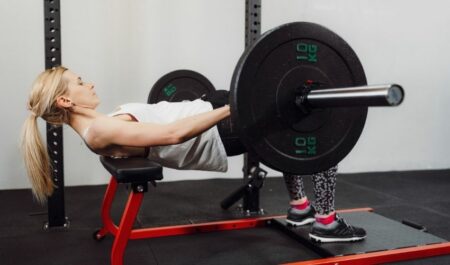
Glute muscles can be targeted with the hip thrust. If you don’t have access to a barbell, try using dumbbells instead. This relocation will necessitate the use of a solid bench as well. As an alternative, do a simple bridge with the addition of weight plates or dumbbells.
- Sit on the floor with your knees bent in front of a weight bench. On a weight bench, the upper back should be resting on the edge. The weight bar should be placed across the hip area.
- Keeping your glutes tight, drive your hips and knees level as you lift the bar. Upper back support should be provided by this bench. Maintain a small chin tuck and focus down your body by keeping your core taut.
- Allowing the hips to rest just a few inches off the floor, slowly drop the barbell down to the floor. Squeeze your glutes and do it all over again. Perform 7 to 10 reps.
The Side Shuffle.
Performing the side shuffle, which is a lateral movement without any weight, offers your legs a little rest. In order to keep your heart rate up and challenge your agility, balance and coordination you’ll be using fast feet to keep your feet moving quickly. Three to five yards apart, use cones or weight plates of various sizes.
- Knees bent and chest elevated, begin at the cone on the right side.
- As soon as possible, shuffle to the left while keeping a low posture.
- Reach down and touch the cone on the left side rapidly, then swiftly reverse your shuffle and return to the right cone. The lateral shuffle should continue for 30 to 60 seconds..
The Superset Type #5.
When you complete your final superset, you’ll be working all three of your body’s major muscle groups—the upper, middle, and lower.
Jammer.
Put a bar on the floor in front of you so that the jammer has something to jam into. On the end closest to your body, place a weight plate. In order to keep it in place, the further end of the rope should be attached to a wall or corner.
- Lie on your back and grab the bar with your palms over the end.
- Using your hips, quadriceps, and gluteus maximus as a source of resistance, force your hips forward and your legs straight.
- Keep your back straight and powerful as you press the bar above.
- As soon as your arms are fully extended, turn the action around. Repeat the movement by lowering the bar and returning to a squat posture. Do seven to ten repetitions.
Cross-Balance Lunge.
Using TRX straps, do a cross-balance lunge to work your abs. Check to see certain your TRX straps are securely fastened to the wall or ceiling before you begin your workout. You may also conduct a side lunge or another version of the curtsy lunge in the absence of straps.
- Take hold of the handles, face the anchor point with your body, and step back until the straps are completely taut. Face each other with hands facing front, arms outstretched.
- In a low curtsy with an erect chest, stretch the left leg behind the right while keeping your core firm. Do this with your left toes on the floor in the distance.
- Return to the starting position by pressing via the right foot. Complete seven to ten sets of each exercise.
Box Jumps.
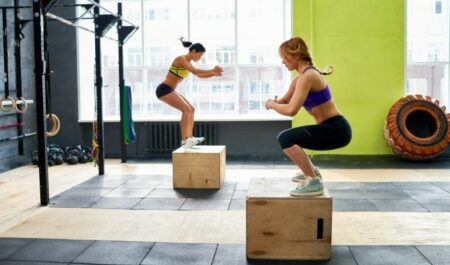
In order to complete this final plyometric technique, you’ll need some sort of platform or box. Glute, hamstring, quadriceps, and calves will be targeted no matter how high the bar is.
- Position yourself in front of the box, feet hip-distance apart. Prepare to jump by bending your knees and lowering your arms behind your back.
- Get on the box by springing up and bouncing about. Use your arms to propel yourself forward and land softly on your heels and knees.
- Get out of the box and start over. Perform 10–12 sets of 10–12 reps.
